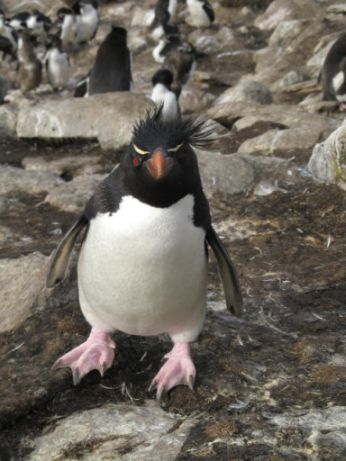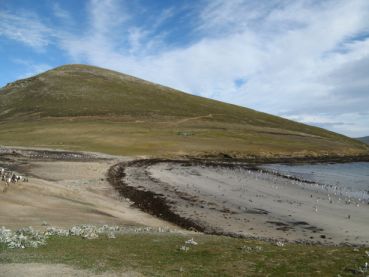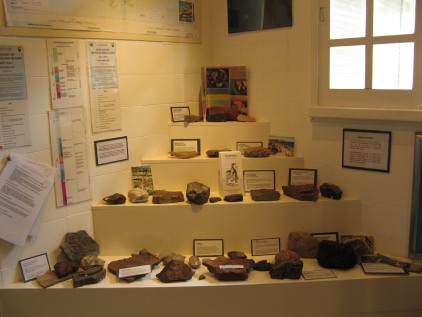 Not the best rock to choose.
Not the best rock to choose.
Sandie
Once a rockhopper had decided upon his/her rock, they were very territorial. If any other rockhopper invaded their space then there was a bit of a fight and squabble as to whose rock it was.
This chap certainly had his pick of the rocks.

Sandie
On my last Sunday, we managed to visit Murrell Farm, near Stanley and see a Rockhopper colony. This was so important to me because we knew Polly would complete seeing all our Edinburgh Zoo penguin species in the wild (as you can see from her entry below, the Rockhopper on Saunders Island) but I had to fit this trip in to be able to experience the rockies.
It was a glorious afternoon, really warm and very little wind. As Polly mentioned, they can scale steep cliffs and I hope you can see from the following photos just how steep.


rockhopper penguins in centre of picture

Another inquisitive resident on Saunders Island – the comical Rockhopper Penguin. These guys can certainly ‘hop’ as their name suggests. They are able to scale steep cliffs (using the claws on their feet) to their nests after jumping out of the surf, with apparently no injuries whatsoever – quite a feat for such a small penguin.
Polly

This is the Striated Caracara – or as it is locally known – Johnny Rook!
There were a small group of these cheeky guys that would hang around our portacabin, ready to investigate us and our things. This one pictured is a juvenile. The adults have a paler beak and more orange/yellow skin around their mouths and yellow legs.
They are very inquisitive birds and have even been known to fly off with visitors’ photograph lens, when the visitor wasn’t looking. Fortunatley I kept a good hold on my equipment and we had to be careful not to keep our front door open otherwise they would wander in. They were a natural alarm clock in the morning as they would bounce around on the tin roof of the cabin.
Polly
Saunders Island is off West Falkland and is a pretty large island with a small settlement/farm where the 5 permanent residents of the island live. They are the owners of the island – the Pole-Evans family. From the settlement it took an hour off road driving to get to my first accommodation at a place called The Neck. It is so called after the neck of beach that attachs a smaller island to the larger island.

On the middle of this photo, you may just about see a small darker area of green – my home for 2 nights!
This neck of beach was teaming with gentoos and magellenic penguins, huddling together in groups. There was also a small colony of King penguins with about 6 small chicks and here and there a pair of Falkland skuas guarding chicks. At one far end of the beach there was also a colony of Rockhopper penguins, many of which are now moulting after their chicks have fledged.
Polly
Thursday 12th February 2009 is the 200th anniversary of the birth of Charles Darwin. Charles Darwin is a naturalist renowned for his theory of evolution by natural selection. His explorations around the world on the HMS Beagle (1831-1836) set the foundations for his work.
He made two visits to the Falkland Islands – 1st March – 6th April 1833 and then on the 9th March – 7th April 1834. It is believed that some fossil finds from the Islands were to have significant impact to the realisation of his theory.
His first impression of the Islands were not impressive ‘the land is low and undulating …. The whole landscape …. has an air of extreme desolation’ . However after a walk around Port Louis he said, ‘The whole aspect of the Falkland Islands, were however changed to my eyes from that walk; for I found a rock abounding with shells; and these of the most interesting age.’
These fossils (about 50 specimens) are now known to be about 400 million years old.
There is a display in the Falkland Island Museum of fossils similar to those Darwin found. (Darwin’s actual fossils are found in The Natural History Museum in London.) The Falkland Island Museum and the National Trust have produced a new brochure for the 2009 celebrations entitled, ‘Charles Darwin in the Falkland Islands’.

Sandie
I left the Falklands on Tuesday 10th February. I had to get a bus from Stanley to the Mount Pleasant Airbase at 5.30am. Since then I have been travelling until I reached home at 7.30pm on Wednesday 11th Feb. It’s a long journey! I am very tired.
Lucky Polly is staying on for another week and spending a few days on Saunders Island. It will be great to find out how she gets on.
I returned because I have been running the Darwin 200 celebrations and one of the major events is our Happy Birthday Mr Darwin Day at Edinburgh Zoo on Thursday 12th February. I felt it appropriate I should return in time.
I have had a wonderful time on the Falklands. I have still got photos and events to report about which happened before I left the islands so my contribution to the blog is not finished. Keep watching.
Sandie